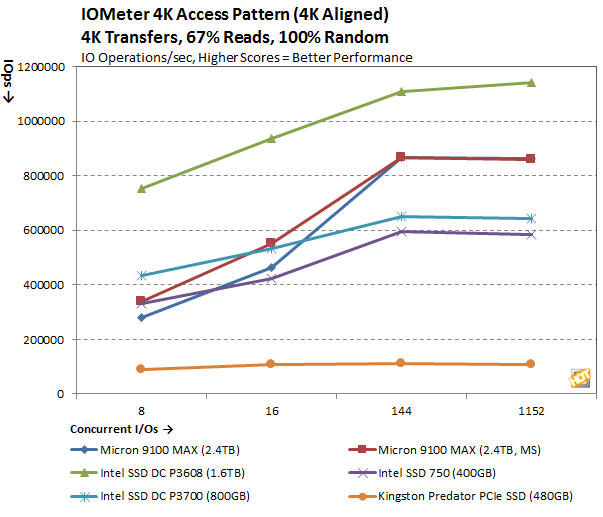Micron 9100 MAX NVMe PCIe Enterprise SSD Review
Test Setup And IOMeter 1.1 RC
Our Test Methodologies: Under each test condition, the Solid State Drives tested here were installed as secondary volumes in our testbed, with a separate drive used for the OS and benchmark installations. Out testbed's motherboard was updated with the latest BIOS available at the time of publication and AHCI (or RAID) mode was enabled. The SSDs were secure erased prior to testing, and left blank without partitions for some tests, while others required them to be partitioned and formatted, as is the case with our ATTO, PCMark 7, and CrystalDiskMark benchmark tests. Windows firewall, automatic updates and screen savers were all disabled before testing. In all test runs, we rebooted the system, ensured all temp and prefetch data was purged, and waited several minutes for drive activity to settle and for the system to reach an idle state before invoking a test.
|
| Processor - Motherboard - Video Card - Memory - Audio - Storage - |
Intel Core i7-6700K Asus Z170 Deluxe (Z170 Chipset, AHCI Enabled) Intel HD 430 16GB Corsair DDR4-2666 Integrated on board Corsair Force GT (OS Drive) Micron 9100 MAX Intel SSD 750 Intel SSD DC P3700 Intel SSD DC P3608 Kingstin HyperX Predator |
OS - Chipset Drivers - DirectX - Video Drivers - Benchmarks Used - |
Windows 10 Pro x64 Intel 10.1.19, iRST 14.5.0.1081 DirectX 11 Intel HD 15.40.3.4248 IOMeter 1.1.0 RC HD Tune v5.60 ATTO v3.05 AS SSD CrystalDiskMark v5.0.2 x64 PCMark 7 SiSoftware Sandra 2015 SP3 |
|
As we've noted in previous SSD articles, though IOMeter is clearly a well-respected industry standard drive benchmark, we're not completely comfortable with it for testing SSDs. The fact of the matter is, though our actual results with IOMeter appear to scale properly, it is debatable whether or not certain access patterns, as they are presented to and measured on an SSD, actually provide a valid example of real-world performance--the access patterns we tested may not reflect your particular workload. That said, we do think IOMeter is a reliable gauge for relative available throughput within a given storage solution. In addition, there are certain higher-end workloads you can place on a drive with IOMeter, that you can't with most other storage benchmark tools available currently.
In the following tables, we're showing two sets of access patterns; our custom Workstation pattern, with an 8K transfer size, 80% reads (20% writes) and 80% random (20% sequential) access and a 4K access pattern with a 4K transfer size, comprised of 67% reads (34% writes) and 100% random access.


As you look at these numbers, keep in mind the Intel DC P3608 is essentially two drives RAIDed together to form a single 1.6TB volume. Also note, we tested the Micron 9100 MAX with Microsoft's NVMe driver and with Micron's own custom driver, hence two sets of numbers for the drive in our charts.
With these access patterns, the P3608 comes out on top, but in comparison to the other drives tested, the Micron 9100 MAX performs very well. As the queue depth increases, the Micron 9100 MAX pulls away from the other single-controller drives, especially with 4K 100% random transfers.

The overall bandwidth numbers are in-line with our IOPS scores above. The Micron 9100 MAX outpaces the Intel DC P3700, especially with the 100% random 4K access pattern.






